Sweet, fleshy and unpretentious tomato "Sensei" - a description of agricultural techniques and advice from experienced summer residents
Working at a summer cottage does not always leave time for experimentation. It is very important to understand in advance which variety will give the best yield. The article will focus on the Sensei tomato, which is a win-win option for those who prefer to get the maximum result with minimum labor costs.
The content of the article
Description and distinctive features
High-yielding and large-fruited variety. The bush of the plant is compact. Leaves are small, dark green, not densely covering the stem. Fruits are collected in clusters of 3-5 pieces. The variety is able to adapt to any weather conditions and feels equally good in dry and rainy summers.
Suitable for all regions of the country and the quality of vegetables does not change depending on whether they are grown in a greenhouse or open field. The only difference is that greenhouse plants can reach one and a half meters, while those that grew in the open air do not even stretch up to a meter.
Fruiting until autumn frosts. In regions with a warm climate, the last green tomatoes are harvested in October, and they ripen well at room temperature. Resistant to almost all diseases typical of tomatoes.
Fruit characteristics and yield
Fruits are even, slightly elongated. The skin is smooth, dense, light raspberry color. The pulp is both dense and soft, it is characterized by juiciness and almost complete absence of seeds. The weight of one tomato is close to 500 grams. The tomato has sugar flesh with a rich, fresh taste.
The yield of the variety is up to 8 kg per sq. m, which makes it ideal for growing in a greenhouse or in the open field in small areas.
Photo
Next, you can see a photo of tomatoes:
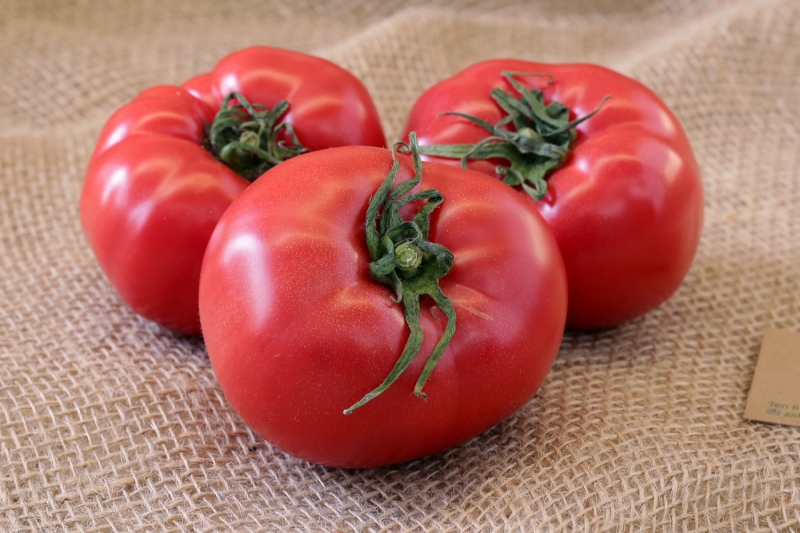

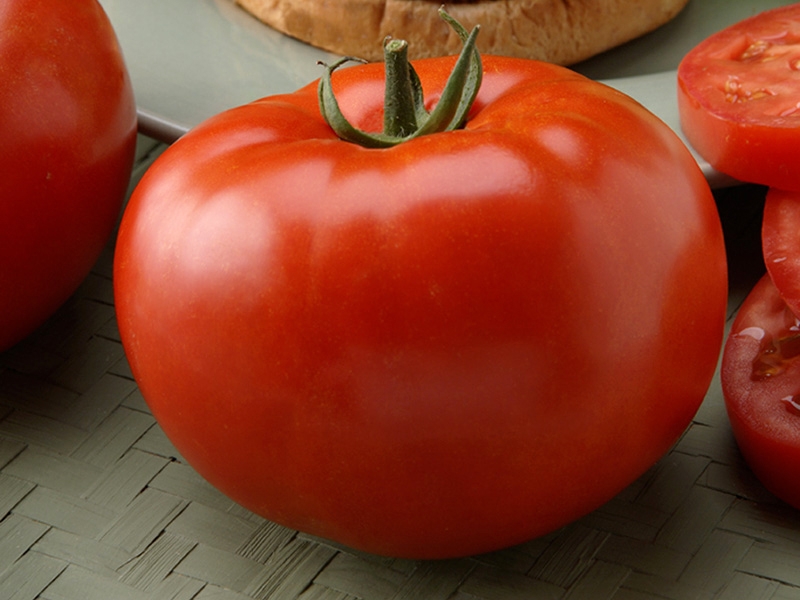
How to grow seedlings
Seed preparation
Seed handling should be started in late March - early April... The seed is soaked in a growth promoter. You can also test the seeds for germination by soaking them in plain water. Non-viable seeds will float to the surface.
Sowing seeds of this variety for seedlings should be carried out 1.5 - 2 months before the intended planting on the beds.
Capacity and soil
You can prepare an earthen mixture for seedlings yourself, or you can purchase a ready-made version in the store. The purchased mixture will be enriched peat soil specifically for tomatoes.
Homemade substrate is prepared according to the following scheme:
- Add one part of peat and river sand to one part of the sod land.
- Stir the resulting composition and spill with a nutrient solution of 30 grams of superphosphate, potassium sulfate and 10 grams of carbamide per 10 liters of water.
Tanks for seedlings can be any, with only one condition that moisture should not stagnate in them, the soil should breathe.
Sowing
Seeds are planted in prepared soil at a distance of 1 cm... apart. Seedlings should be sprinkled with earth, watered and covered with foil.
Care
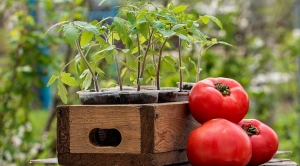 The temperature under the film should be maintained at +20 degrees until the first shoots appear. Immediately after this, the film should be removed, and the sprouts should be regularly watered and kept warm in the room.
The temperature under the film should be maintained at +20 degrees until the first shoots appear. Immediately after this, the film should be removed, and the sprouts should be regularly watered and kept warm in the room.
Best of all, the container with seedlings will feel on the windowsill from the sunny side. As soon as the young plants have real leaves, they can be planted in separate pots.
Competent picking is one of the prerequisites for obtaining viable seedlings.
- Individual small pots are filled with prepared soil, in which a hole is made so deep that the plant fits in it up to the cotyledon leaves.
- Mineral fertilizer for tomatoes, diluted in advance, according to the instructions, is poured into the hole, and then the plant is placed.
- After two weeks, the seedlings can be fertilized again.
- Watering is carried out as the soil dries out in the pots.
Growing tomatoes
Landing
- The plant is planted in a permanent place after warm weather is finally established and the earth is well warmed up.
- The distance between landings should be at least 45 cm.
- The soil must be previously loosened.
- Small depressions are prepared in the garden for future bushes, into which mineral phosphorus fertilizer is applied.
- After planting, young plants should be watered.
Care
Watering
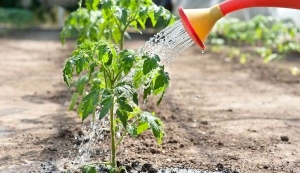 The variety is undemanding to moisture, enough watering at the root once a week... In this case, do not allow moisture to enter the leaves.
The variety is undemanding to moisture, enough watering at the root once a week... In this case, do not allow moisture to enter the leaves.
The water temperature for irrigation should be about +20 degrees in hot weather and + 24-26 degrees in cool. 3-5 liters of water are applied to each bush.
The first watering is carried out a week after planting. The beginning of fruit formation is a signal to reduce watering.
Weeding
Weed control should be started almost immediately after planting to prevent damage to the tomato root system.
Loosening
Avoid the formation of a dense crust on the soil surface, therefore regular loosening is shown.
Stealing
Lateral shoots growing from the leaf axils are manually removed. This helps to control the thickening of the plantings and direct the forces of the plant to fruiting.
Bush shaping
This tall variety requires one or two stems. The growth of the top is necessarily limited.
Garter
Sensei is a tall variety and therefore requires a garter... For this, a wooden or metal support is mounted near each bush, and the plant is tied up at the top. After the fruits appear, the branches are also fixed on the support.
Top dressing
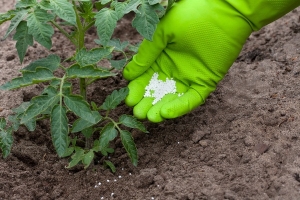 Top dressing is carried out four times per season. It is best to purchase ready-made, balanced formulations for this.
Top dressing is carried out four times per season. It is best to purchase ready-made, balanced formulations for this.
- For the first feeding, which is carried out 2-3 weeks after planting the seedlings, mineral fertilizers containing phosphorus and potassium should be used.
- Second stage of feeding falls on the period when the second brush opens. At this time, the plant needs organic fertilizers.
- Third is carried out similarly to the second, after the next brush has opened.
- Fourth stage fertilization means foliar feeding. It is carried out at a time when it is important to preserve all flowers. The plant is sprayed with mineral fertilizers at the rate of 1 tsp. for 1 liter. water with the addition of half a micronutrient tablet.
Features and possible difficulties
When choosing a place for planting the Sensei variety, remember that potatoes and eggplants cannot be the predecessors of the crop.
The area where onions, cabbage, carrots or zucchini were previously grown is best suited. It is not recommended to plant seedlings in the same place. two years in a row. Tomato Sensei is not suitable for soils with an excess of organic matter.
Diseases and pests
The variety is highly resistant to diseases typical of nightshades, such as:
- late blight;
- fusarium wilting;
- alternaria;
- tobacco mosaic.
However, this does not exclude the need for prophylaxis, which consists in regular weeding, airing and spraying the plantings with antifungal biological products.
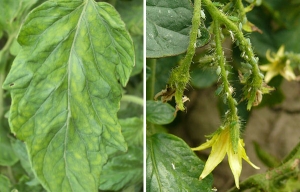 Often harmful insects attack fresh tomato greens, which greatly weakens the plants and can lead to their death. Irreparable harm can be caused by:
Often harmful insects attack fresh tomato greens, which greatly weakens the plants and can lead to their death. Irreparable harm can be caused by:
- Colorado beetles;
- aphid;
- thrips;
- spider mite.
Preventive measures in pest control include regular plant inspections. In the event that an attack has already occurred, it is important to destroy the insects in a timely manner with the help of insecticides.
If slugs have attacked the tomatoes, then they should be collected by hand, and then the plantings should be treated with an aqueous solution of ammonia.
Nuances for tomatoes in the open field and in the greenhouse
Indoor ground requires special attention to disease prevention... In greenhouse conditions, it can be difficult to maintain the desired humidity level. For Sensei tomatoes, it should be low enough.
For open ground, Sensei makes requirements for the timely planting of seedlings - it is unacceptable to place young plants in unheated ground - this will lead to their death.
Harvesting and application of the crop
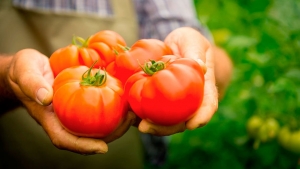 "Sensei" bears fruit until the first frost... Throughout the season, harvesting the fruits should be carried out as they ripen, while you should not delay removing the tomatoes from the bush, since they are very heavy and can damage the branches.
"Sensei" bears fruit until the first frost... Throughout the season, harvesting the fruits should be carried out as they ripen, while you should not delay removing the tomatoes from the bush, since they are very heavy and can damage the branches.
October fruits can be harvested still green and left to ripen in room conditions.
This large-fruited variety is great for salads and making fresh or canned juices.
Advantages and disadvantages
The advantages of the Sensei variety include:
- Unpretentiousness.
- Excellent taste of the fruit.
- High yield.
- Disease resistance.
- Versatility. Can be grown both indoors and outdoors.
Cons of the variety:
- The need to form a bush to get a good harvest.
- Demanding feeding.
Farmers reviews
“There is no place for small-fruited varieties in my small garden. It is important that the bushes are not spreading, but at the same time they give large yields. Sensei is the perfect find. The tomatoes are very large, there are many of them and they are of good quality. "
“Great taste. Tomatoes fly straight from the garden into salads. Fresh vegetables are very much appreciated in our family, so the ability of “Sensei” to ripen at home, after picking green fruits in October, is important for us. In November and December salads with fresh tomatoes flaunt on our table. "
“I don't have the opportunity to visit the dacha more than once a week, and the Sensei variety with its undemanding watering is just a godsend for me. It is a miracle when such a wonderful result is obtained without much effort. "
Conclusion
The combination of amazing unpretentiousness, excellent taste and the ability to long-term fruiting - all this is the characteristic of the Sensei tomato variety. The variety allows the most productive use of the space allocated for it, due to its high yield. Compliance with the rules for care will allow the variety to maximize the characteristics laid down in it by the breeders.